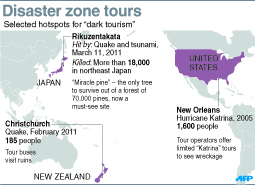Sunday Times 2
Dark tourism brings light to disaster zones
View(s):RIKUZENTAKATA, Japan (AFP) – Before the huge tsunami virtually wiped it off the map in 2011, Rikuzentakata’s pristine beach and luxuriant pine forests were a well-worn stop on Japan’s tourist trail.
Now the visitors are coming back, but this time they want to see the devastation and the monuments to those who died, the latest example of a phenomenon dubbed “dark tourism” where holidaymakers pay to witness the aftermath of others’ misery.
“You can’t really get a sense how huge the tsunami was unless you actually come here and see,” said Akira Shindo, 15, from New York, on a recent tour of part of Japan’s devastated northeast coast.
More than 18,000 people were killed when a 9.0-magnitude undersea quake sent huge waves barrelling into Japan.
Whole communities were destroyed, buildings turned into matchwood and acres of prime land left unfarmable when a furious sea smashed ashore.
In Rikuzentakata, a forest of 70,000 pine trees that had protected the city from ocean winds for 300 years was swept away. Just one tree — the “miracle pine” — survived the ravages of nature. It has undergone 150 million yen ($1.5 million) of reinforcement to prop it up and has now become a must-see spot for visitors to the area.
Everyone AFP spoke to on the tour of Rikuzentakata expressed horror at the suffering of people whose lives were torn apart by the tragedy.
But disaster zones undoubtedly draw their fair share of ghoulish sightseers.
Seven years after Hurricane Katrina devastated the United States city of New Orleans, residents of one hard-hit area became so fed up with the hordes of gawking tourists feasting on their misery that they got the city to ban tour buses.
A hand-painted sign on one street corner summed up their frustration in dripping black paint: “Tourist — shame on you. Driving by without stopping. Paying to see my pain. 1,600 died here.”
Residents in Christchurch, New Zealand, where 185 people died in a February 2011 earthquake that flattened the downtown area, have grown accustomed to buses disgorging camera-wielding visitors at sites such as the ruins of the Anglican cathedral, once the symbol of the city.
On a very practical level, tourists spend money — often at a time when a devastated area desperately needs jobs and investment to get back on its feet.
Akira Oikawa, who sells fish, seaweed and other processed marine products, said the post-disaster day-trippers to Rikuzentakata and the nearby area were helping to make up the shortfall.
“We are grateful for tourists visiting here and buying local products, as we saw a drop in the number of tourists after the disaster,” he said.
“But it’s hurtful when people ask casually about how many people died,” he added. “We appreciate a little bit of empathy.”
Follow @timesonlinelk
comments powered by Disqus

